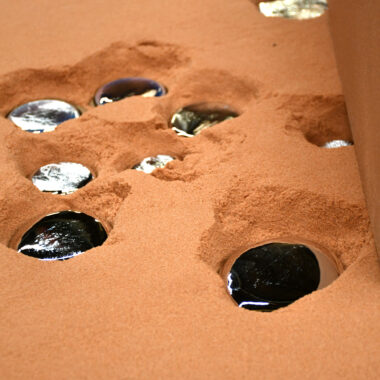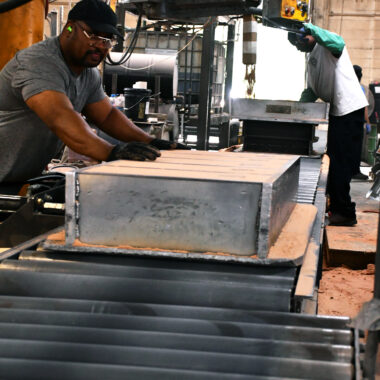Exploring the Craft: All About Aluminum Casting Techniques
Exploring the Craft: All About Aluminum Casting Techniques
Blog Article
From Design to End Up: The Total Light Weight Aluminum Casting Refine Demystified
In the world of manufacturing, the procedure of light weight aluminum spreading stands as an essential technique that has sustained sectors for years. Each step in this detailed procedure, from the initial style stage to the final complements, plays a crucial function fit the outcome of the item. What really exists below the surface of this process stays a secret to lots of. By unraveling the intricacies and clarifying the subtleties included in each phase, a deeper understanding of the art and science behind light weight aluminum spreading arises. about aluminum casting. Remain tuned as we explore the complete aluminum casting process, discovering the complexities that change raw materials into refined items.
Designing the Casting Mold And Mildew
When initiating the light weight aluminum casting procedure, careful attention to developing the spreading mold and mildew is extremely important for making sure the last item's stability and high quality. The spreading mold acts as the foundation for the entire spreading process, determining the shape, measurements, and surface coating of the ultimate light weight aluminum component.
To create an effective spreading mold, engineers have to take into consideration numerous factors such as the intricacy of the part, the type of light weight aluminum alloy being utilized, and the preferred properties of the end product. about aluminum casting. Computer-aided design (CAD) software is often used to produce in-depth schematics of the mold and mildew, enabling specific modification and optimization
In addition, the style of the casting mold straight impacts the performance and cost-effectiveness of the casting process. A properly designed mold and mildew minimizes material waste, lowers the demand for extensive post-casting machining, and enhances general production rate.
Melting and Pouring Light Weight Aluminum
With the style of the casting mold and mildew completed, the next crucial action in the light weight aluminum casting procedure is the melting and putting of the light weight aluminum alloy. The process starts with loading the light weight aluminum alloy into a furnace where it is warmed to its melting point, commonly around 660 ° C(1220 ° F) for aluminum. Crucible heaters, induction heaters, or gas-fired reverberatory heating systems are typically utilized for melting light weight aluminum. When the light weight aluminum is molten, it is important to maintain the temperature level within a particular variety to make certain the quality of the spreadings.
The liquified light weight aluminum is carefully moved from the heater to the spreading mold. Proper pouring strategies add significantly to the total top quality of the last aluminum spreading.
Cooling and strengthening Refine
Upon completion of the putting procedure, the molten aluminum shifts into the cooling down and solidifying phase, a vital phase in the light weight aluminum spreading process that directly impacts the final item's stability and qualities. As the light weight aluminum starts to cool down, its particles prepare themselves right into a solid form, slowly taking on the shape of the mold and mildew.
During this stage, it is vital click here to read to control the cooling procedure carefully to prevent flaws such as porosity, shrinking, or internal anxieties. Different air conditioning approaches, such as air cooling, water quenching, or controlled cooling chambers, can be used based upon the certain demands of the spreading (about aluminum casting). By keeping an eye on and managing the solidification and cooling procedure, suppliers can ensure the manufacturing of top notch light weight aluminum spreadings with the desired metallurgical and mechanical properties

Getting Rid Of the Final Spreading
When the aluminum spreading has actually completely strengthened and cooled in the mold, the following action in the process includes very carefully eliminating the last casting. This step is critical to guarantee that the light weight aluminum component is effectively drawn out with no damage or issues.
To get rid of the casting, the mold is opened, and the spreading is extracted using various approaches depending on the complexity of the mold and mildew and the part style. For simpler shapes, the casting can typically be easily removed by hand or with simple click for info tools. Nevertheless, for more complex designs, additional devices such as ejector pins, air blasts, or hydraulic systems might be needed to promote the elimination process without triggering any type of damage to the spreading.
After the casting is successfully removed from the mold and mildew, any type of excess material such as gates, joggers, or risers that were made use of during the spreading procedure are trimmed off. This step aids in accomplishing the final preferred shape of the aluminum part prior to it undertakes any additional completing processes.
Finishing and Top Quality Inspection
The final stage in the light weight aluminum spreading process includes meticulous ending up methods click to read more and extensive top quality examination methods to make sure the stability and accuracy of the cast aluminum parts. Completing techniques such as grinding, fining sand, and shot blasting are used to get rid of any type of excess product, smooth harsh surface areas, and enhance the visual charm of the final item. These processes not just improve the look however also guarantee that the parts satisfy the specified dimensional resistances and surface coating demands.

Conclusion
Finally, the aluminum spreading process entails developing the mold, melting and putting light weight aluminum, solidifying and cooling the spreading, eliminating the end product, and ending up with a top quality examination. Each step is crucial in making certain the end product satisfies the preferred specifications. By understanding the entire process, producers can create top notch light weight aluminum spreadings successfully and successfully.
Keep tuned as we study the total light weight aluminum casting procedure, uncovering the intricacies that transform raw products right into refined products.
With the style of the casting mold and mildew completed, the next crucial step in the light weight aluminum spreading process is the melting and putting of the aluminum alloy.Upon completion of the pouring procedure, the liquified light weight aluminum transitions right into the strengthening and cooling down phase, an essential phase in the light weight aluminum casting procedure that directly impacts the last item's stability and attributes.The last phase in the aluminum casting process involves careful completing methods and extensive quality evaluation methods to ensure the honesty and precision of the actors light weight aluminum parts.In conclusion, the light weight aluminum spreading process entails designing the mold, melting and putting aluminum, cooling down the casting and solidifying, removing the final product, and finishing with a top quality assessment.
Report this page